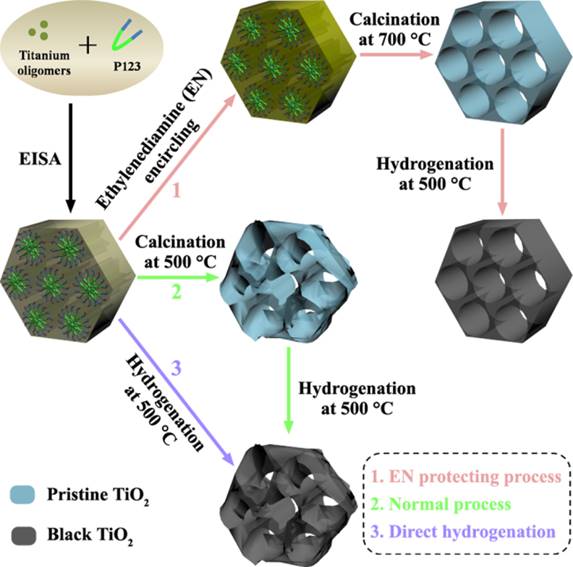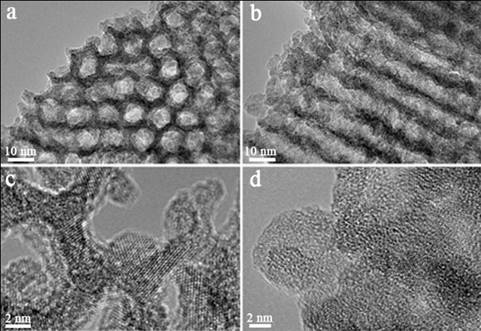J. Am. Chem. Soc. 2014, 136, 9280-9283.

Wei Zhou, Honggang Fu*, Dongyuan Zhao*, Ordered Mesoporous Black TiO2 as Highly Efficient Hydrogen Evolution Photocatalyst (J. Am. Chem. Soc. 2014, 136, 9280-9283.)
Mesoporous TiO2 materials with interpenetrated and regular mesopore systems have recently triggered enormous research activities because of their fascinating features such as low cost, environmental benignity, good chemical stability, excellent electronic and optical properties, high specific surface areas, tunable mesostructures and pore sizes. While they possess great potential in photocatalysis, photoelectrochemical (PEC) water splitting and photovoltaic (PV) cells, it is more intriguing to explore the possibility of enhancing and/or extending their properties by increasing the solar-light adsorption and improving the charge separation and transportation. Until this date, numerous efforts involving engineering bandgap, maximizing crystallinity, optimizing exposed facets and controlling heterojunctions have been carried out worldwide to design and pursue high-performance mesoporous TiO2 materials. Recently, Mao and coworkers have demonstrated a novel approach to enhance the solar harvesting by introducing disorder in the surface layers of high crystalline TiO2 nanoparticles through hydrogenation. The resultant hydrogenated TiO2 nanocrystals showed the optical absorption shifts from the ultraviolet (UV) to near infrared, accompanied by a dramatic color change from white to black. Since then, much work has been devoted to the synthesis and design of black TiO2 materials, which truly represent a big breakthrough in the photocatalytic splitting. However, the mostly investigated black TiO2 materials usually possess a poorly porous structure with limited surface areas of lower than 50 m2 g–1, which are generally composed of irregular nanoparticles.
Herein, we report the facile synthesis of ordered mesoporous black TiO2 (OMBT) materials (Figure 1), which exhibit excellent photocatalytic hydrogen evolution performances. In this case, the employment of a thermally stable and high-surface-area mesoporous TiO2 as the hydrogenation precursor is the key for fabricating the OMBT materials, which not only facilitate H2 gas diffusion into TiO2 and interaction with their structures, but also maintain the ordered mesoporous structures, as well as inhibit the phase transformation (from anatase to rutile) and crystal growth during hydrogenation at 500 °C. The resultant OMBT materials possess a high surface area of ~ 124 m2 g-1, a large pore size and pore volume of ~ 9.6 nm and 0.24 cm3 g-1, respectively. More importantly, the OMBT materials can extend the photoresponse from ultraviolet (UV) to visible and infrared light regions, and exhibit a high solar-driven hydrogen production rate (136.2 μmol h-1), which is almost two times as high as that of pristine mesoporous TiO2 (76.6 μmol h-1).

Figure 1. Representative TEM images along (a) [100] and (b) [110] plane, and (c, d) HRTEM images of the ordered mesoporous black TiO2 materials.
